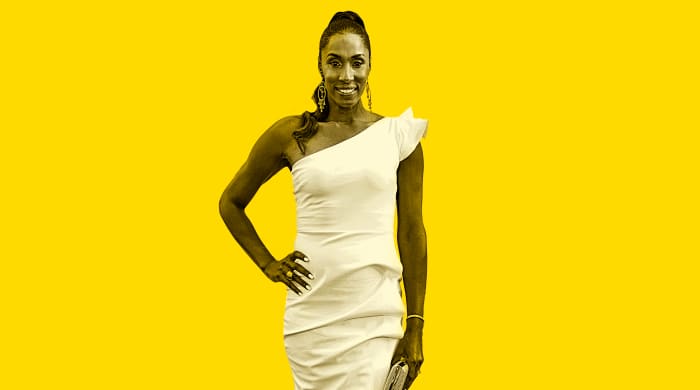
[ad_1]
Sports Illustrated and Empower Onyx are putting the spotlight on the diverse journeys of Black women across sports—from the veteran athletes, to up-and-coming stars, coaches, executives and more—in the series, Elle-evate: 100 Influential Black Women in Sports.
When Lisa Leslie was a 6-foot-tall sixth grader growing up in Compton, Calif., she had trouble understanding why everyone assumed she played basketball just because of her height. By the next year, Leslie decided she wanted to be more than just the tall girl in school—and she wanted to be more popular—so she followed in the footsteps of a well-known classmate who was on the team and decided to play for real.
Leslie quickly discovered that she was the only left-handed player at practice. In an effort to join her teammates, she switched and trained with her right hand, just so she wouldn’t have to do the drills alone. That decision would impact the rest of her life and set her on a path as one of few ambidextrous players in the WNBA, confidently finishing with either hand.
“I’ve always approached life like I approached the game,” says Leslie, 49. “Somebody’s got to be the best, so why not me?”
If there is anybody who could patent the formula for success, it’s Leslie. Anything the basketball legend has touched seems to turn to gold. From her introduction to the game to starring at USC and joining the inaugural Sparks team, Leslie’s list of on-court accomplishments is long: three-time WNBA MVP, two-time WNBA champion, Hall of Famer, first woman to dunk in the league, first player to reach 6,000 points in her career, four-time Olympic gold medalist and more.
Today, Leslie is your favorite player’s favorite player turned co-owner, after she became the first former WNBA player to invest in a team when she rejoined the Sparks in 2011. She’s also an author, public speaker and a coach in the BIG3, where she helped the Triplets win the league title in 2019.
But Leslie knows there is a lot more to her own success in sports and in life than just being ubertalented and having the archetypical “athletic” form. She’s remained relevant and revered by constantly innovating new ways to approach the game and executing them with perfect care and consistent grit. Nothing is too hard for her to master, no task too daunting.
When she transferred to a junior high school without a girls’ basketball team, she kept that same energy and played with the boys, because, well, why not her? At 14, she was already receiving more than 100 recruitment letters from colleges, including Division I programs at Stanford and Tennessee. That attitude would carry her through high school as one of Morningside High’s greatest players in school history. Leslie was the team’s top scorer and rebounder, leading her team to the 1989 California state championship before she officially became the top player in the country in her senior year.
That win would lead to a scholarship at USC, nationally known for its indomitable team and coaching staff, where she played from 1990–94. Playing in a total of 120 college games where she averaged 20.1 points, with 53.4% shot accuracy and 69.8% free throw accuracy, she continued to set the tone for what women in the sport could execute and dominate.
Leslie challenged and reset the standard in all areas of her game, including Pac-10 records for scoring 2,414 points, 1,214 rebounds and 321 blocked shots, including the most blocked shots at USC in a single season, at 95. There was no shortage of accolades during college career: the 1994 Naismith College Player of the Year, the USBWA Women’s National Player of the Year award, the Honda Sports Award, and the WBCA Player of the Year, plus All-American honors in 1992, ’93 and ’94.
Amid all the on-court honors, Leslie always remained focused on setting herself up for a life after basketball, graduating with a bachelor’s degree in communications and later earning a master’s in business administration.
“I’m a better and more educated person because of basketball,” she says.
After school, she continued her legacy of influencing and propelling the sport into the future, as one of the first players drafted into the WNBA at its inception in 1996. The rest is a long history of firsts: first woman to dunk a ball in the WNBA, on July 30, 2002; first player to score 3,000, then 4,000, and eventually 6,000 total career points; the Sparks’ career scoring and rebounding leader; first player to reach 10,000 career PRA (points, rebounds, and assists); and more.
In 2009, Leslie retired. But for one of the most influential, groundbreaking basketball players of all time, nothing slowed down at all. She made her mark as an author, releasing her autobiography, Don’t Let the Lipstick Fool You, in ’09; served as a color commentator and analyst; joined the Sparks as part owner; was officially inducted into the Basketball Hall of Fame in ’15; and dedicated her life to leading the next generation of young people in basketball with the Lisa Leslie Basketball & Leadership Academy.
Like choosing lefty, like being the first of the first, like playing with the boys, Leslie is never scared, whether she excels or falls.
“People want to see the heart and the effort,” she says. “That really outweighs the wins and the losses.”
Naya Samuel is a contributor for Empower Onyx, a diverse multichannel platform celebrating the stories and transformative power of sports for Black women and girls.
[ad_2]
Source link

